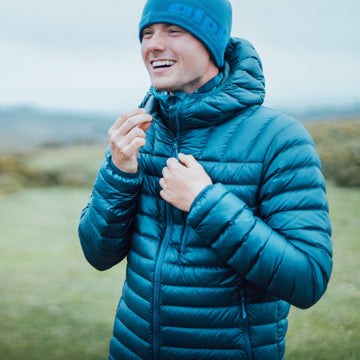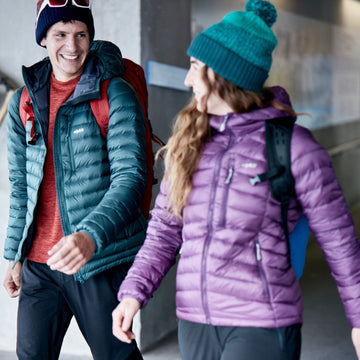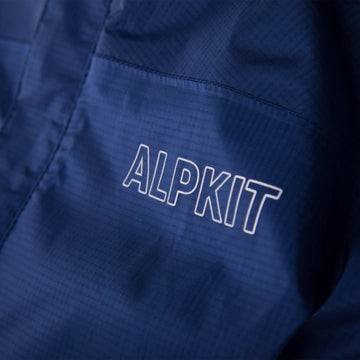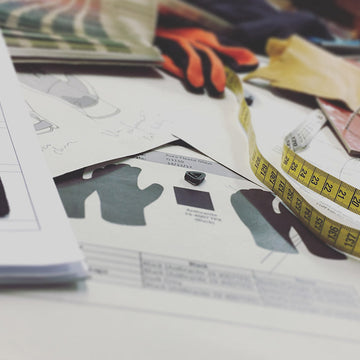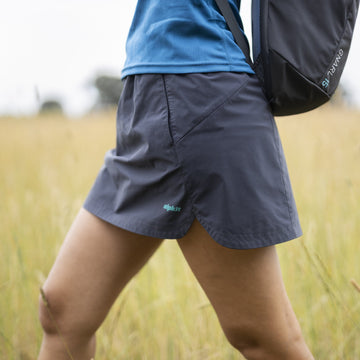
Waterproof jacket jargon got you confused? Understand waterproof and breathability ratings with this simple guide to make choosing gear much more accessible.
Buying a waterproof can feel like learning a new language! But knowing how breathable waterproof fabrics work can help you Waterproof jacket Buying Guide">decide which one to buy as well as how to look after it and extend its life.
Guide to Breathable Waterproofs
What is hydrostatic head?

The hydrostatic head (HH) rating tells you how much water pressure your jacket can handle before it lets water in. It’s measured using a column of water (10cm diameter for the fabric geeks out there). The value signifies the height of the column required for water to leak through. We recommend that you look for a minimum of 10,000mm HH for most activities, or at least 20,000 for proper all-weather use. Alpkit’s waterproofs range from 10,000 – 30,000mm).
What waterproof rating do I need?

Generally speaking, the more you use your jacket, the more rain it will need to endure, so the higher the hydrostatic head you’ll need. It's also worth saying that rucksack straps increase the water pressure on your waterproof as they push water through the fabric. If you’re often wearing a heavy rucksack, you may need a waterproof with a higher hydrostatic head.
What is moisture vapour transmission rate?

What is moisture vapour transmission rate?
One measurement of breathability is Moisture Vapour Transmission Rate (MVTR), measured in grams per square metre per day (g/m²/24hrs). Breathable fabrics are fabrics that allow moisture to pass from inside the fabric to the outside.
What breathability rating do I need?
We recommend the following guidelines for MVTR:
- 8,000 is suitable for sedentary activities
- 10,000 – 15,000 is breathable enough for most activities where you’d expect to sweat a bit – e.g. hillwalking
- 20,000 is excellent for intense activities when you’ll really be pushing yourself
Don't get hung up on the numbers
MVTR is a tricky measurement: there are multiple methods for testing it and each method favours different fabrics. Manufacturers usually just quote the most flattering results for their garments, which can make comparisons difficult.
Why is my waterproof jacket wet inside?
alpkit definition waterproof jacket, a 100% PFC-Free Mountaineering Waterproof" height="607" loading="lazy" sizes="(max-width: 375px) 375px, (max-width: 450px) 450px, (max-width: 540px) 540px, (max-width: 650px) 650px, (max-width: 760px) 760px, (max-width: 864px) 864px, (min-width: 865px) 910px" src="https://cdn.shopify.com/s/files/1/0253/1626/1993/files/How-do-waterproof-jackets-work-2_2048x2048.jpg?v=1631185868" srcset="https://cdn.shopify.com/s/files/1/0253/1626/1993/files/How-do-waterproof-jackets-work-2_2048x2048.jpg?v=1631185868&width=375 375w, https://cdn.shopify.com/s/files/1/0253/1626/1993/files/How-do-waterproof-jackets-work-2_2048x2048.jpg?v=1631185868&width=450 450w, https://cdn.shopify.com/s/files/1/0253/1626/1993/files/How-do-waterproof-jackets-work-2_2048x2048.jpg?v=1631185868&width=540 540w, https://cdn.shopify.com/s/files/1/0253/1626/1993/files/How-do-waterproof-jackets-work-2_2048x2048.jpg?v=1631185868&width=650 650w, https://cdn.shopify.com/s/files/1/0253/1626/1993/files/How-do-waterproof-jackets-work-2_2048x2048.jpg?v=1631185868&width=760 760w, https://cdn.shopify.com/s/files/1/0253/1626/1993/files/How-do-waterproof-jackets-work-2_2048x2048.jpg?v=1631185868&width=864 864w, https://cdn.shopify.com/s/files/1/0253/1626/1993/files/How-do-waterproof-jackets-work-2_2048x2048.jpg?v=1631185868&width=950 950w" width="910">
If moisture can’t pass through your jacket fast enough, it will accumulate on the inside of the jacket and feel wet - The moisture you produce when exercising needs somewhere to escape to. The most waterproof jacket in the world won’t be very comfortable if it's not breathable.
Humidity
Breathability in waterproof jackets depends on 'solid state diffusion': water vapour is absorbed through the fabric and passed to the other side. The water vapour will always try to move to the least humid side of the fabric to maintain an equilibrium. In most conditions this means the water passes from the inside to the outside of the jacket. However, when it’s very humid, your jacket will feel less breathable.
Air permeability
Air permeability is the measurement of how much air a fabric allows to pass through it. Not all waterproofs have an air permeability rating, but jackets with this rating will probably have a lower MVTR than jackets without. This doesn’t necessarily mean they’re not as breathable, as you’re less likely to overheat when you’ve got a bit of airflow in your jacket.
Features
Pockets in your jacket can affect the breathability because they add another layer of fabric to your jacket. Some jackets have crafty mesh pockets to reduce fabric and allow you to dump excess heat and sweat too.
Dirt and abrasion
Dirt and abrasion could be stopping your DWR from working, reducing breathability. Cleaning your waterproof jacket can prevent this.


![Balance [Mens]](http://eu.alpkit.com/cdn/shop/files/balance-mens-2025-reef.jpg?v=1765566341&width=768)
![Balance [Mens]](http://eu.alpkit.com/cdn/shop/files/Balance-mens-2.jpg?v=1765566341&width=768)
![Balance [Womens]](http://eu.alpkit.com/cdn/shop/files/balance-womens-2025-black.jpg?v=1765566432&width=768)
![Balance [Womens]](http://eu.alpkit.com/cdn/shop/files/Balance-womens-3.jpg?v=1765566432&width=768)
![Fortitude [Mens]](http://eu.alpkit.com/cdn/shop/files/fortitude-mens-2025-alder.jpg?v=1765566372&width=768)

![Fortitude [Womens]](http://eu.alpkit.com/cdn/shop/files/fortitude-womens-2025-alder.jpg?v=1764270237&width=768)


![Definition [Mens]](http://eu.alpkit.com/cdn/shop/files/Definition-men-2.jpg?v=1764357328&width=768)

![Definition [Womens]](http://eu.alpkit.com/cdn/shop/files/Definition-women-3.jpg?v=1764357395&width=768)



![Talini [Womens]](http://eu.alpkit.com/cdn/shop/files/talini-1.jpg?v=1764183225&width=768)


![Filoment Vest [Womens]](http://eu.alpkit.com/cdn/shop/files/womens-filoment-vest-2024-celestial-COLOUR-CHANGE.jpg?v=1762282643&width=768)
![Filoment Vest [Womens]](http://eu.alpkit.com/cdn/shop/files/Filoment-Vest_AW24_Womens_Chamonix_3908_1.jpg?v=1762282643&width=768)

![Filoment Hoody [Mens]](http://eu.alpkit.com/cdn/shop/files/AW25-Chamonix-JW-5042_2.jpg?v=1765566497&width=768)
![Filoment Hoody [Womens]](http://eu.alpkit.com/cdn/shop/files/womens-filoment-2024-celestial-COLOUR-CHANGE.jpg?v=1764356431&width=768)
![Filoment Hoody [Womens]](http://eu.alpkit.com/cdn/shop/files/Camping-Arran-9548_1.jpg?v=1764356431&width=768)





